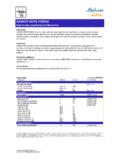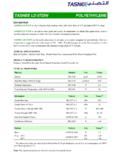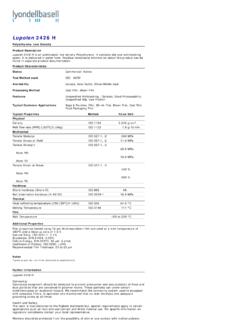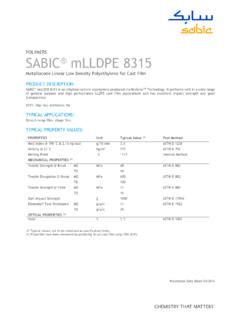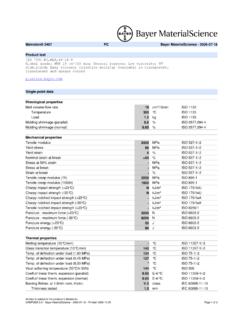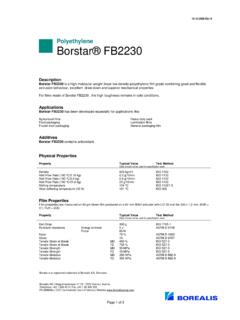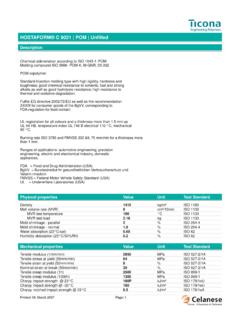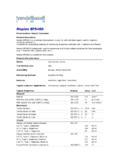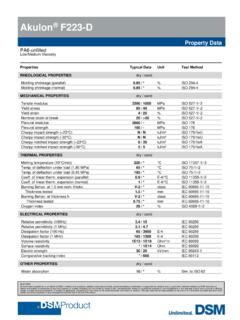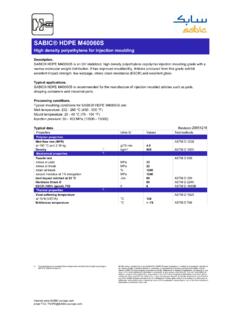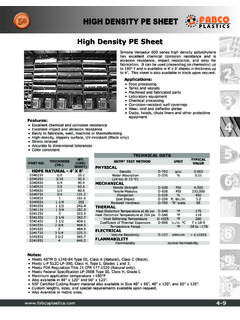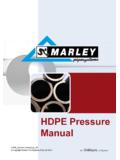Transcription of SABIC® HDPE B5429 - b2bPolymers.com
1 SABIC HDPE B5429 high density polyethylene for Blow HDPE B5429 is a medium molecular weight high density polyethylene copolymer. It is primarily intended for blow moulding bottles of small sizes. SABIC HDPE B5429 offers an excellent combination of toughness, stress cracking resistance (ESCR), load bearing strength and processability HDPE B5429 is classified as a multipurpose blow moulding grade. It may be blow moulded into containers for household and industrial chemicals ( detergents, bleach, fabric softeners, solvents, paints, etc.), automotive supplies, foodstuffs, toiletries and cosmetics. It can also be used in other hollow thin-walled parts and profile HDPE B5429 has been run on the latest high speed blow moulding machines at maximum rates to produce articles of excellent quality. Moulded parts exhibit outstanding surface appearance.
2 The recommended melt temperature for this grade is between 165 and 215 SIValuesTest methodsTypical propertiesMelt flow rate (MFR)ASTM D 1238at 190 C and kgg/10 190 C and kgg/10 min291)Densitykg/m 954 ASTM D 15052)Mechanical properties2)Tensile testASTM D 638stress at yieldMPa30stress at breakMPa32strain at break%850secant modulus at 1% elongationMPa1150 Izod impact notched at 23 CJ/m200 ASTM D 256 Hardness Shore D-67 ASTM D 2240 ESCR (100% Igepal), F50h90 ASTM D 1693 BThermal properties2)Vicat softening temperatureASTM D 1525at 10 N (VST/A) C128 Brittleness temperature C< -75 ASTM D 746 All information supplied by or on behalf of the SABIC Europe companies in relation to its products, whether in the nature of data, recommendations or otherwise, is supported by research and believed reliable, but the relevant SABIC Europe company assumes no liability whatsoever in respect of application, processing or use made of the afore-mentioned information or products, or any consequence thereof.
3 The user undertakes all liability in respect of the application, processing or use of the afore-mentioned information or product, whose quality and other properties he shall verify, or any consequence thereof. No liability whatsoever shall attach to any of the SABIC Europe companies for any infringement of the rights owned or controlled by a third party in intellectual, industrial or other property by reason of the application, processing or use of the afore-mentioned information or products by the ) high load melt flow rate has been found to be more accurate )Test specimens are prepared from compression moulded sheet made according to ASTM D 1928 Procedure HDPE B5429 high density polyethylene for Blow mouldingGeneral information. The SABIC HDPE product range for blow moulding and extrusion is produced in a slurry or gasphase process using a Cr catalyst.
4 The primary characteristic of SABIC HDPE grades is a broad molecular weight distribution, which ensures excellent behaviour during characteristics are a high purity, excellent stability during processing and a high intrinsic toughness. The carefully balance of environmental stress crack resistance and stiffness is becoming visible on grade application area: bottles, cans, containers and technical articles, sheet and thermoforming, profiles and tubes for pressure less , Safety and Food Contact regulations. Detailed information is provided in the relevant Material Safety Datasheet and or Standard Food Declaration, available on the Internet ( ). Additional specific information can be requested via your local Sales SABIC Europe is fully certified in accordance with the internationally accepted quality standard ISO 9001-2000.
5 It is SABIC Europe's policy to supply materials that meet customers specifications and needs and to keep up its reputation as a pre-eminent, reliable supplier of and handling. Polyethylenes resins (in pelletised or powder form) should be stored in such a way that it prevents exposure to direct sunlight and/or heat, as this may lead to quality deterioration. The storage location should also be dry, dust free and the ambient temperature should not exceed 50 C. Not complying with these precautionary measures can lead to a degradation of the product which can result in colour changes, bad smell and inadequate product performance. It is also advisable to process polyethylene resins (in pelletised or powder form) within 6 months after delivery, this because also excessive aging of polyethylene can lead to a deterioration in and recycling.
6 The environmental aspects of any packaging material do not only imply waste issues but have to be considered in relation with the use of natural resources, the preservations of foodstuffs, etc. SABIC Europe considers polyethylene to be an environmentally efficient packaging material. Its low specific energy consumption and insignificant emissions to air and water designate polyethylene as the ecological alternative in comparison with the traditional packaging materials. Recycling of packaging materials is supported by SABIC Europe whenever ecological and social benefits are achieved and where a social infrastructure for selective collecting and sorting of packaging is fostered. Whenever 'thermal' recycling of packaging ( incineration with energy recovery) is carried out, polyethylene -with its fairly simple molecular structure and low amount of additives- is considered to be a trouble-free
